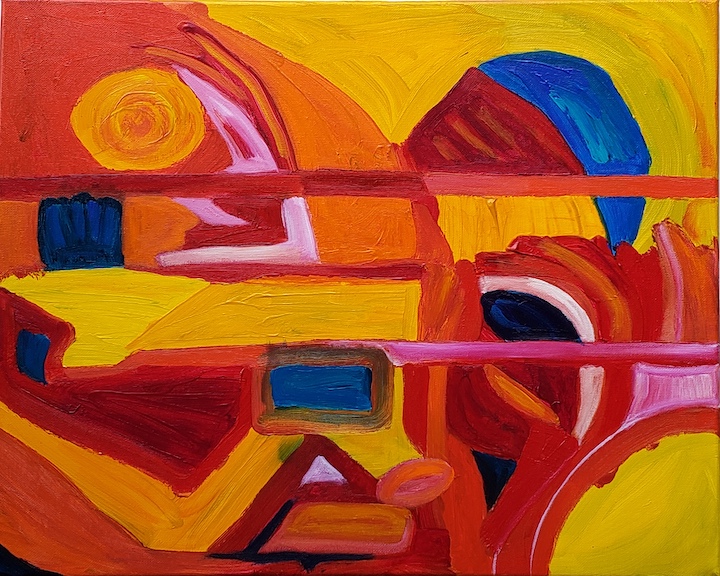First of two parts
STANDING along the banks of the Connecticut River or by the edge of a field or forest, I paint images without forethought or a finished scene in mind. Wholly immersed in my environment, my thoughts and feelings emerge without interruption or prejudice.
Occasionally I complete a painting in the field. Sometimes less is more, and the original needs no further embellishment.
More often, though, I leave with a painting’s essence rather than its entirety as I merge with my surroundings rather than objectify them. I seek the exalted state athletes know as “flow,” when mind and body are in perfect sync without thought or effort.

IT HAS BEEN SAID that the best way to paint an object like a peach or an avocado is to imagine oneself directly on its skin. The mental trick of eliminating the distance between subject and object through the memory of touch induces a deep level of observation. I feel the avocado in order to paint it.
Robert Henri, in his book, Art Spirit, writes at length about the role of the model in portraiture. The essence of a good portrait, says Henri, is in its inspiration; that initial moment when the painter chose to paint a certain pose, mood, or expression.
From that moment on, things change. The model attempts the exact pose, but a shoulder may be more relaxed, a wrist slightly bent. The emotion expressed by the model at the outset changes, too, and is reflected subtly in his or her gaze, the rose of the cheeks, the curl of the lips.
The quality of light may be central to the portrait. Yet it, too, varies from one minute to the next. The painter’s thoughts and feelings continually change, too. Only by returning to that initial moment again and again can the painter fully unleash its power.
After the first session, the model becomes a kind of guide or placeholder; the physical details are less important. The painter must ignore the model’s subtle changes or sacrifice something of the inspiration’s potency.
***

MY GOAL in plein air painting is to become as innocuous as a beetle or bumblebee, doing what comes naturally; to participate in the world rather than be an observer, without attempting to manipulate or impose my will on my environment.
Everything has its place in nature, from the deer that host the ticks that feed the possums to the flowers that nourish pollinators and give human beings such sensory pleasures. When I take my art supplies out into nature, my role is simple: to simply paint.
Yet unlike the rabbit or eagle, I bring a complex set of thoughts and emotions with me: the beautiful and nuanced relationships I have with other people, but also climate change and pandemic and social injustice, fueled by my specie’s ignorance, hubris, and greed.
My feelings, good and bad, accompany me in my few hours in the wild and inevitably find expression on my canvases as I mingle with the natural world.
I begin with a simple premise. It might be a color — perhaps the first tube I pull out of my bag of paints. It might be using a palette knife or cloth instead of a brush. I might paint with my opposite hand or in my bare feet. Anything to get started.
Whatever I choose becomes my pathway to the unknown. Sometimes I recognize my meaning or motives immediately. At other times, my primitive first attempts remain a mystery.
Returning to my studio, I see that the colors and shapes do not always tell an entire story. The composition may need refining, the colors enriched. Yet the marks I made in the field create a powerful mood and structure for the painting to come. The painting is true to the moment.
I continue to work on these canvases, teasing out their stories. The bones are solid, even if I don’t initially know how to piece them together, which I eventually do, adding flesh and blood.


Russell, your insightful comments resonate with me in a number of ways, but particularly, I love the way you make the analogy of an athlete’s “flow” of mind and body; a melding of energy; I have experienced that when deeply involved with sculpting in wood. In addition, your words, “primitive first attempts remain a mystery”: how true this is with many things we find our selves set upon.
Sunset/River is powerful.
Holland
Thank you, Holland. I often struggle to find words for this non-verbal experience. Glad that it came through! Looking forward to more!
I love this writing as the thought process monitors the journey of feeling and expression that emerges in the paintings. It seem similar to a video and a soundtrack presented separately for us to shape.
Pandemic Postcards is very strong, as is River Sunset.
It is a beautiful river by any and all accounts. Few see it so clearly as you.
Thank you, Jonathan. High praise from a Water Rat!! The journey, like the river, flows on. So glad for a compatriot so attuned to the river’s beauty and subtleties. I appreciate the feedback.